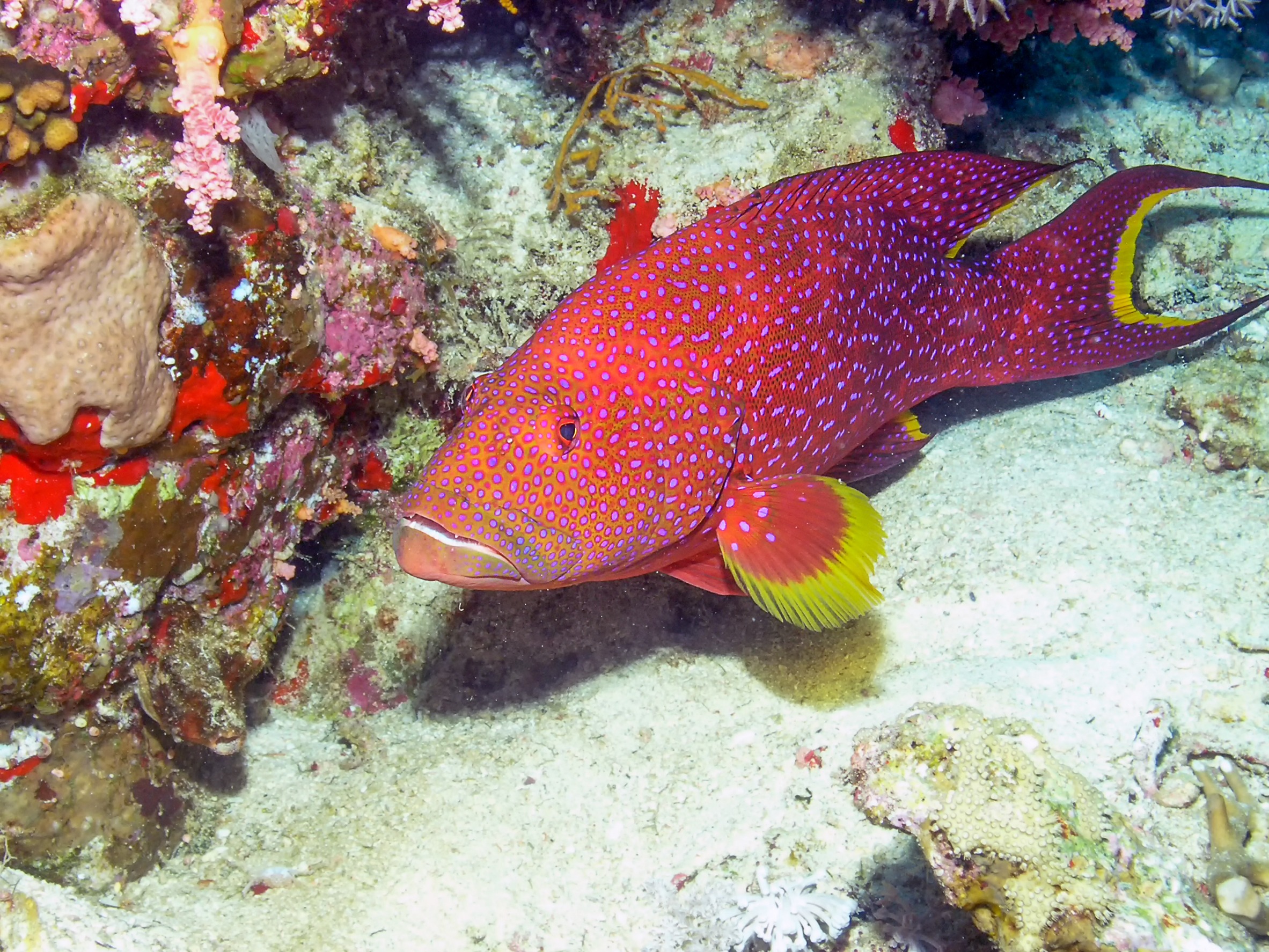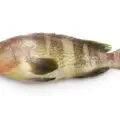There are so many species of grouper in the world that people often forget about the varieties found worldwide. One such species of grouper is the lyretail grouper. The scientific name for the lyretail grouper is Variola louti. This fish is familiar under many names worldwide, such as yellow-edged coronation trout, fairy cod, lunar-tailed cod, lyre-tail cod, or moon-tail seabass. It is another ray-finned fish that commercial and recreational fishermen highly prize due to its beautiful appearance and delicious flesh.

What does the lyretail grouper look like?
First, you should know how to locate a lyretail grouper when you see one. To achieve that, you have to know what the fish looks like. Therefore, here is a detailed explanation of the appearance of this species of grouper fish.
The appearance of the fish changes drastically from when it is juvenile to when it is mature. However, as most groupers do, the fish has an elongated body with a pointed head and a large mouth. The length of the head is longer than the depth of the body. The fish’s lower jaw extends outward to the upper jaw. The mouth is lined with small yet sharp teeth designed to swallow the prey whole.
When it comes to the color, the overall color of the fish is reddish, and the body is covered in blue and pink spots on the head, body, as well as fins. This reddish color fades from orange to white on the lower part of the body. The rear margins of the dorsal fins, anal fins, and caudal fins are yellow, almost highlighting the edges. It is a beautiful and colorful grouper species, making it a favorite among anglers.
However, when the fish is juvenile, the body color of the fish is yellow, with the upper part being a darker yellow and the lower part fading to a light yellow. The body is covered in blue spots. The main difference is that there are a series of dark black blotches on the mid-body and a prominent circular black spot on the caudal area on juvenile fish. With age, the fish’s body turns red, and the edges of its fins start turning yellow.
What is the lifespan of lyretail grouper?
There is not much information about the lifespan of this grouper because it is a pretty hidden species that only a few people know about. Considering how many different grouper species there are, it is easy to have some that are more well-known than others.
Like most groupers, the lyretail grouper has a lifespan of around 10 to 15 years. Most grouper fish take a long time to reach maturity and have a long lifespan. These fish do not die naturally very early, but most creatures in the sea do not live long due to external factors. The environmental conditions affect the lifespan and stress condition of the fish significantly. The availability of food and other predators in their habitat determines how long these fish live.
If there is enough food, they can live longer; similarly, if there are not many predators of lyretail grouper, it will survive longer. Moreover, like other grouper fish, the lyretail grouper survives and lives the longest in the wild, in its natural habitat. If it is forced to live in a small space like a tank which is not entirely accurate as its habitat, the fish dies pretty early due to stress. Not to mention, some fish cannot survive in captivity, and this is one such fish, even if it is a beautiful fish that will look exceptional in a tank.
What is the size of the lyretail grouper?
The size of the lyretail grouper is another reason it cannot live in a tank. This fish is pretty large, and they keep growing as they age. The older the fish caught, the bigger it could be. Of course, some lyretail fish will also be naturally smaller, especially female fish.
Lyretail groupers can grow up to a maximum length of around 50 centimeters (20 inches) and weigh approximately 2 kilograms (4.4 pounds). However, the typical size and weight of adult individuals are usually smaller than this, with most lyretail groupers being around 30-40 centimeters (12-16 inches) in length and weighing between 500 grams (1.1 pounds) and 1 kilogram (2.2 pounds). Also, this fish’s maximum recorded total length is 83 centimeters (33 in), weighing 12 kilograms (26 pounds).
It is not as significant as other grouper fish, especially considering the goliath grouper. However, the fish is substantial compared to other fish in its habitat. The size of the fish also depends on its habitat. With more food and less stress, the fish will grow and focus on developing more.
What is the habitat of lyretail grouper?
The habitat of lyretail grouper is less vast than some other groupers. This fish is found in selected areas only. The fish has an Indo-Pacific distribution and is located in the Red Sea through the tropical Indian Ocean east into the Pacific Ocean.
The fish is found in South Africa, Japan, and South Australia. In 2018 and 2019, the fish was also seen in the eastern Mediterranean Sea off Cyprus. This could be due to the introduction of the fish by releasing there or because it gradually migrated from the Red Sea.
When it comes to where in the ocean this fish is found, well lyretail groupers are primarily found in shallow coral reefs and rocky areas with clear water, where they hunt for small fish and crustaceans as their primary food source, but these fish can also be found in the water at depths of up to 50 meters (164 feet). The lyretail grouper prefers warmer water with temperatures ranging from 25-30°C (77-86°F) and typically inhabits areas with strong water currents, which help bring in a steady food supply. They are generally solitary or found in pairs and are known to be territorial in their selected area.
What is the diet of lyretail grouper?
Since lyretail grouper is a reef fish, it is known for eating whatever it finds there. These fish are opportunistic eaters, which is why the fish can be seen eating a wide variety of things.
The fish is a predatory species that feed on prey, including small fish, crustaceans, and other invertebrates. The fish eat mostly fish and crabs, shrimp, stomatopods, small fish such as gobies, cardinalfish, and damselfish, and crustaceans such as shrimps. Lyretail groupers may also occasionally consume cephalopods such as squid or octopus. These fish can be used as bait when luring the fish into fresh water because they are known to hide to stalk their prey.
The way that the fish eats food is by hunting for it. The fish actively hunt for food during the day, particularly during periods of strong water flow. They are known to ambush their prey by hiding in crevices or behind rocks and coral and then rapidly swimming out to capture their target, which makes it harder for anglers to find them.
How does lyretail grouper reproduce?
There needs to be more information about how the fish reproduces because it is not a very famous grouper species. However, it is assumed that, like most other grouper species, it follows a protogynous hermaphrodite lifestyle.
We know that the female lyretail fish reaches maturity at a standard length of 33 centimeters (13 in), after which it is ready to reproduce. We also know that this species of groupers are oviparous, meaning they lay eggs.
The male fish courts the female fish by displaying its bright colors to attract the fish. Once a pair has formed, the female will release her eggs into the water column, and the male will fertilize them externally. These fish have been recorded forming spawning aggregations off Aceh in Sumatra. Also, they reproduce during colder months which are between December and February.
After the eggs are fertilized, they are buoyant. They will float in the water column until they hatch into larvae, which will undergo a series of developmental stages before settling onto the reef as juveniles. It is rare for aquarists to breed this species of grouper inside. Still, there are reports of some people succeeding in replicating the reproduction process inside.
What does lyretail grouper taste like?
The lyretail grouper is a valuable fish food, but it is only eaten sometimes. This is because there have been reports of ciguatera poisoning, leading to the fish being banned from sale in Mauritius. Japan and some other Asian countries sell fish for eating, but it is not common.
However, due to their rarity, Yellow-edged lyretails are considered a high-quality food fish. They are prized for their firm, white flesh, which is mild and sweet in flavor. The meat has a delicate texture and is often compared to the taste of other high-quality grouper species. It does not offer a unique taste but can be cooked in many ways. It absorbs the flavor of marinades well, and you should try it at least once.
When buying fish to eat, it is vital to select a trustworthy seller to prevent it from carrying any poison and tasting the best. The taste of the fish depends on many factors, like where it was caught, its diet before being caught, the age of the fish, and much more. Regardless, it is a good-tasting fish that is also rare, so it is a delicacy to taste it at least once.
How to catch the lyretail grouper?
Lyretail grouper are caught in the same way as other grouper. You must first select an appropriate location near reefs where the fish will be hiding.
Since this fish likes to stay hidden, the best way to lure it out is by using bait, live or dead. Live baits such as small fish, crabs, or shrimp are often used to attract the fish, and lures or jigs that mimic the movements of small prey can also be effective. Using chum or scent attractants can also help to lure yellow-edged lyretail to the area because the fish likes to stalk its prey.
When to catch the lyretail grouper?
The lyretail grouper can be caught all year round, depending on your locality’s laws. These fish are the most active and feed more aggressively during strong water movement and tidal changes. They are often found in shallow waters near coral reefs, rocky areas, or other structures where they can hide and ambush their prey. These fish are usually found in deeper waters. Still, they can also come to shallow water to search for food or even during the breeding season.
Conclusion
In conclusion, the lyretail grouper is an incredible species of marine life that has been around for thousands and thousands of years. It is a large, colorful fish found in tropical waters worldwide. It is also often kept as a pet in aquariums. While they are not difficult to care for, they require plenty of space and a proper diet. Despite their intimidating size and appearance, lyretail groupers are actually very gentle.











